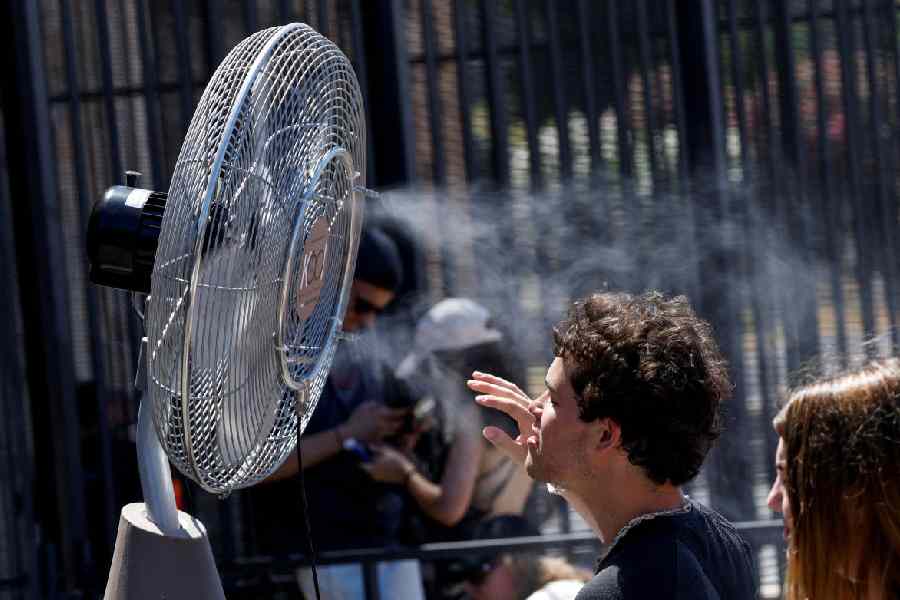 |
| Metro report on April 14 on the Kingfisher ATR’s close shave |
The Kingfisher ATR that had come within colliding distance of an Emirates A330-200 near Calcutta a fortnight ago was “tossed around like a leaf” during turbulence moments earlier, forcing the commander to raise altitude without air traffic control’s permission.
The cockpit report sent to the Directorate-General of Civil Aviation tells a scary story that is far more common than fliers would have imagined. According to aviation experts, the squalls that Calcutta eagerly awaits at the start of the swelter season are a threat to all short-haul ATR aircraft.
“The ATR (the 72-500 series is more popular in India) is considered very safe for commercial operations. But they don’t have the altitude advantage of bigger aircraft, which is a problem during the pre-monsoon season in the east,” said a flight engineer with a private airline.
A twin turbo-prop ATR 72-500 can carry up to 74 passengers and fly at a maximum altitude of 25,000 feet, but the 15,000-18,000 feet range is considered cruising altitude for a plane of that size. The problem is that maximum turbulence in the pre-monsoon months occurs between 12,000 and 20,000 feet.
“Cumulonimbus clouds are not the only threat. Turbulence can occur for up to 20 miles during severe thunderstorms,” a Met official said. “There can be both upward and downward draught, which can force the aircraft up or down from its flying altitude.”
Calcutta witnesses frequent thunderstorms at this time of the year. There have been six since March this year.
So do airlines restrict ATR operations during the pre-monsoon season? No, they don’t.
Around 10 ATR aircraft from the Kingfisher, Jet Airways, Air India and Deccan fleets fly regularly between Calcutta and the Northeast, Jharkhand and other short destinations.
On April 4, the Kingfisher ATR had taken off for Ranchi with 40 passengers and a four-member crew on board when turbulence struck. Pilots Abhishek Sahay and S. Tiwari have said in their report that the squall tossed up the plane nearly 700 feet and shut down its autopilot system.
The flight’s radar screen showed the formation of magenta and red-coloured cumulonimbus clouds, which trigger extreme turbulence.
The pilots immediately sought a diversion of 40 nautical miles, or 74 kilometres south off the Calcutta-Ranchi route.
“However, after flying on the parallel route for around 50 nautical miles or 92 kilometres from Calcutta, the ATR aircraft again flew north and entered the main route. The pilots stated that the radar could not measure the actual turbulence,” an official said.
After flying for 20 minutes on the main route, the pilots apparently started experiencing turbulence and asked passengers to fasten their seatbelts.
The pilots immediately sought a diversion of 40 nautical miles, or 74km, south of the Calcutta-Ranchi route.
The report states that after flying for another 10 minutes the aircraft was caught in such severe turbulence that autopilot went blank.
When the pilots asked for permission to climb to 18,000 from 16,000 feet, air traffic control replied “negative”, according to the report.
The aircraft was then thrown up several hundred feet within a span of 10 seconds. “The pilots manually controlled the plane following the rule-book. Holding the joysticks, they had to maintain optimum speed so that the plane did not suffer structural damage or stalling,” the report says.
According to flight manuals, an ATR aircraft caught in turbulence should maintain an average speed of 180 nautical miles (333.36km) and proper flying position or tilt. “If the speed is higher, then the tilt will also increase, causing the aircraft to stall and crash. If the speed is slower and the pilot tries to dive, there can be structural damage,” a pilot said.
Airport officials said the Kingfisher pilots’ report would be compared with the black-box records











